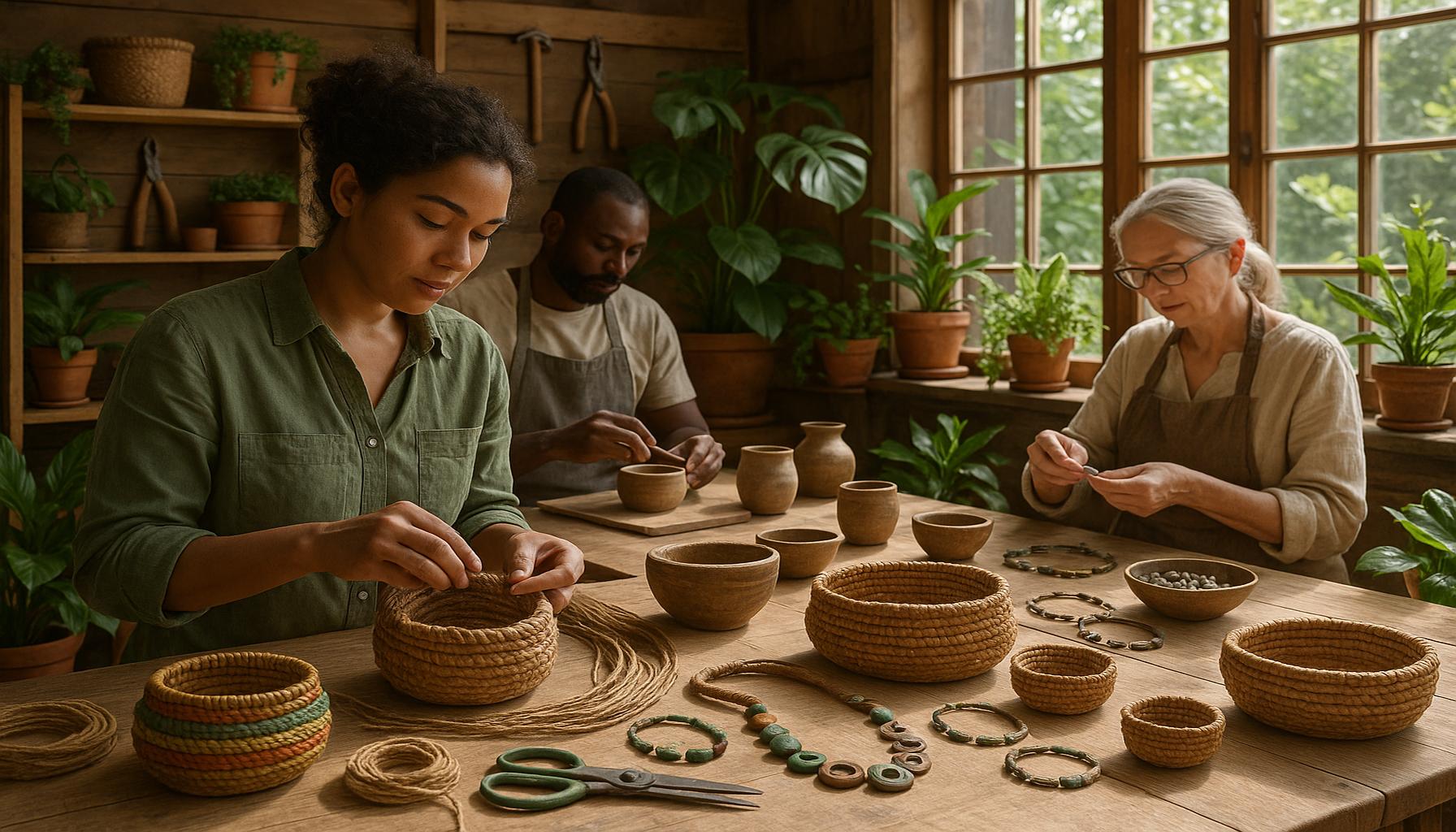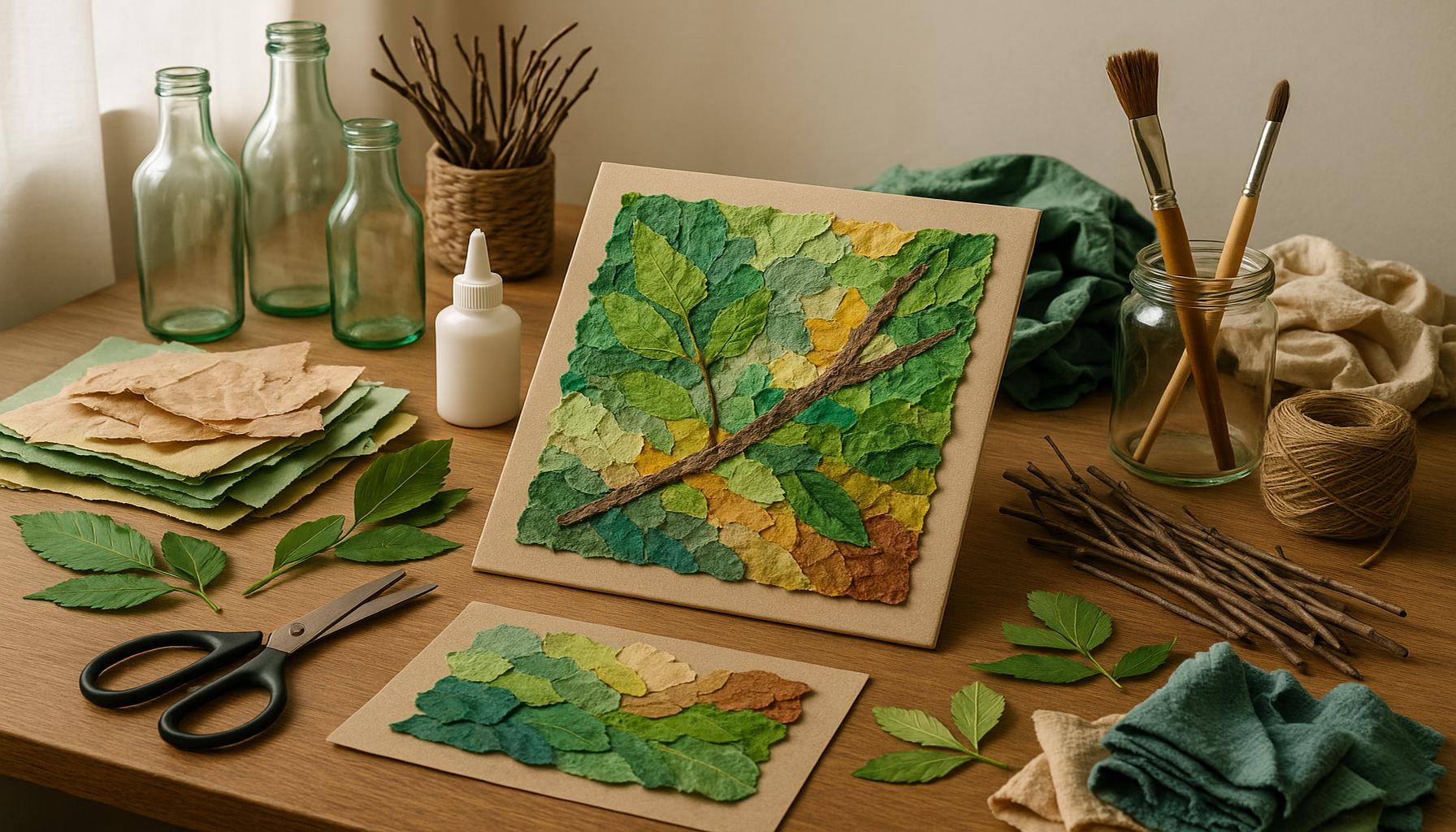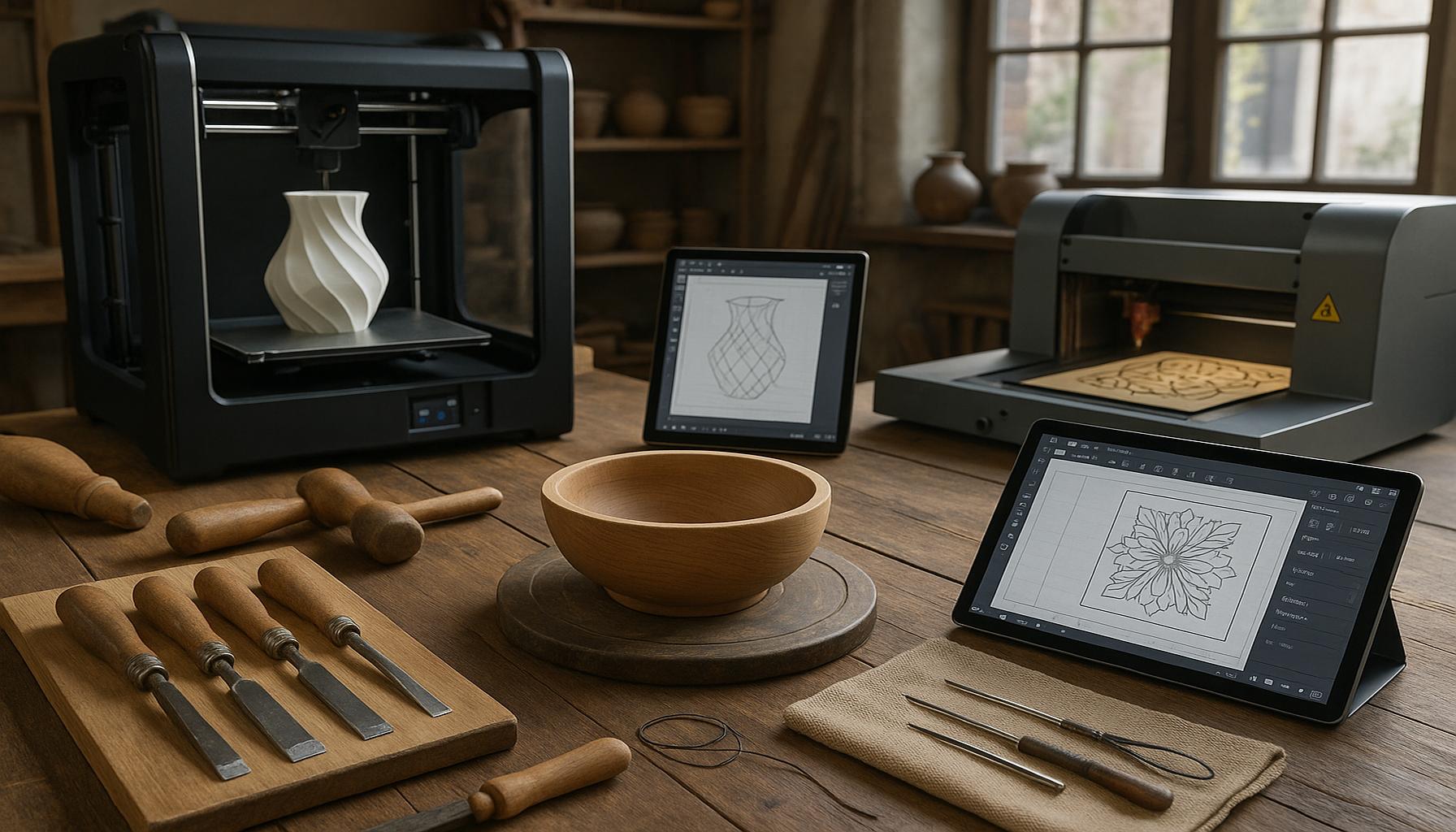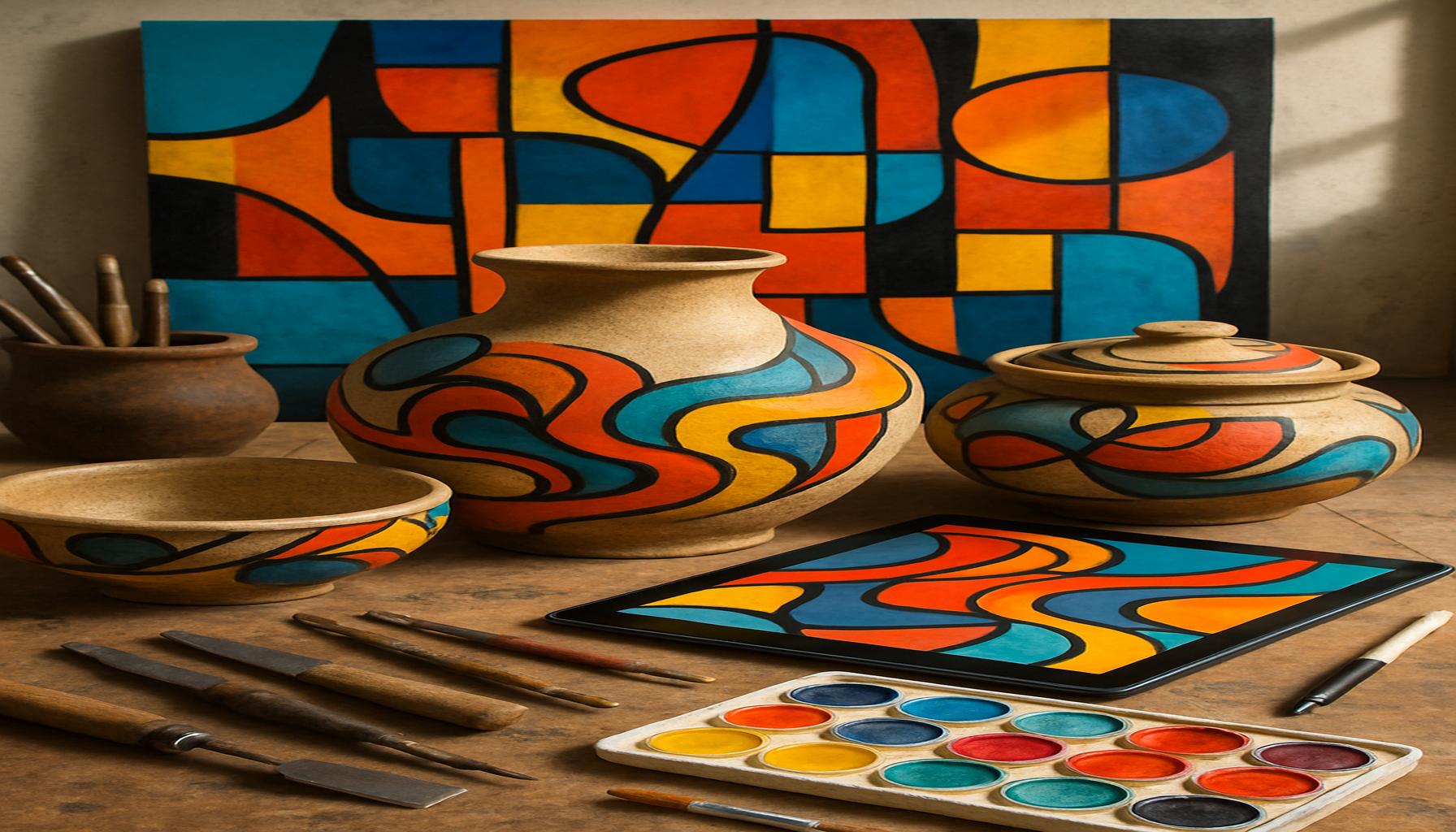Sustainability in Handicrafts: Eco-Friendly Practices for Conscious Creators

Understanding the Shift Towards Eco-Conscious Creativity
In recent years, the rising awareness surrounding environmental challenges has prompted a remarkable evolution within the handicraft sector. As craftspeople become more attuned to sustainable practices, they are making intentional decisions regarding the materials they use and their production methods. This integral shift not only supports the health of the environment but also attracts a new breed of consumers who prioritize eco-friendliness in their purchasing choices.
One of the key strategies in this sustainable movement involves using recycled materials. Artisans across the United States are creatively repurposing discarded items—such as old furniture, fabric scraps, and even plastic waste—to construct unique and functional pieces. For instance, some artisans transform salvaged wood into stunning home décor items or fashion accessories, giving new life to materials that would otherwise contribute to landfill waste. This innovative approach not only reduces waste but also tells a compelling story of resilience and creativity.
Another prominent practice among eco-conscious makers is the choice of natural dyes. These environmentally friendly colorants, derived from plants, minerals, and even insects, are gaining traction as competent alternatives to synthetic dyes. For example, indigo and madder root can create vibrant hues while remaining non-toxic and biodegradable. Craftspeople using these dyes are not only enhancing the sustainability of their products but also preserving the rich history of textile traditions that celebrate natural color sources.
Low-impact production techniques head further towards sustainability by minimizing waste. Artisans are adopting meticulous planning and efficient crafting methods to ensure maximum utilization of resources. Techniques such as zero-waste pattern making in sewing and modular design in woodworking stand out as examples of how thoughtful design can lead to sustainable practices without sacrificing creativity and quality.
These initiatives do more than just reduce environmental impact; they contribute to the preservation of traditional artisan skills, which might otherwise be overshadowed by mass production. The stories behind such products often create genuine connections with consumers, fostering a burgeoning interest in supporting sustainable creators. As markets begin to favor eco-friendly products, the momentum behind this movement continues to grow.
This discussion leads us to explore the various intricate practices that propel sustainability in handicrafts. Throughout the United States, we will spotlight inspiring artisans who are paving the way in this sector. As we unravel their stories, we will also provide practical tips for emerging creators aspiring to infuse sustainability into their own work.
DISCOVER MORE: Click here to uncover new painting techniques
Pioneering Paths: Innovative Eco-Friendly Practices
As the movement toward sustainability gains traction in the handicrafts sector, artisans are stepping up to showcase an array of innovative eco-friendly practices that embody their commitment to environmental stewardship. This dedication to sustainable craftsmanship not only elevates their creative output but also fosters a conscious community of consumers eager to engage with products that are both beautiful and responsible.
Utilizing Upcycled Materials emerges as a defining trait of modern handicraft. Upcycling not only extends the lifecycle of products but transforms them into something entirely new. For instance, Los Angeles-based artist Jessica Lee uses discarded skateboard decks to craft unique jewelry pieces, expertly blending style with sustainability. Her creations resonate with an environmentally aware market, reflecting the ethos of recycling while telling a story of the materials’ previous lives.
Furthermore, artisans are increasingly embracing local sourcing for their materials. This approach minimizes transportation emissions and supports local economies, making it a double win for sustainability. By choosing to work with nearby suppliers, creators can ensure that the materials they use are of high quality while also reducing their carbon footprint. Artisans such as Mark Hagan, a furniture maker from Portland, Oregon, often collaborate with local sawmills to source reclaimed wood that speaks to the unique heritage of their surroundings.
In addition to selecting materials mindfully, many creators are shifting towards low-energy production methods. This includes techniques that require less energy than traditional manufacturing processes, such as hand-tools and solar-powered equipment. By adopting these methods, crafters like Emily Chen are working to lower their environmental impact while producing handcrafted items, such as eco-friendly ceramics that shine with personal touch and character.
Eco-Friendly Techniques in Practice
While the specific materials may vary, a common thread among eco-conscious artisans is their commitment to using holistic techniques that embody the principles of sustainability. Here are a few noteworthy practices:
- Natural Finishes: Artisans often favor natural waxes and oils over chemical-based finishes to preserve the integrity of their work while protecting the environment.
- Energy Efficiency: Using renewable energy sources whenever possible, such as incorporating solar panels into workshops, is becoming a standard for many makers.
- Community Engagement: Some craftspeople host workshops and events to educate the public about sustainable practices, fostering a sense of community and shared responsibility.
These eco-friendly practices are not merely trends—they represent a profound shift in how handicrafts are produced and consumed. As consumers increasingly seek eco-conscious products, these artisans are not just making a living; they are also redefining the narrative around what it means to be a creator in the 21st century. This movement harmonizes with a growing demand for transparency and authenticity in consumer choices, paving the way for a sustainable future.
| Category | Key Features |
|---|---|
| Recycled Materials | Utilizes existing materials to reduce waste and conserve resources. |
| Natural Dyes | Incorporates plant-based dyes which are less harmful to the environment compared to synthetic options. |
| Local Sourcing | Supports local economies while minimizing transportation emissions that contribute to climate change. |
| Eco-Friendly Packaging | Reduces plastic use by implementing biodegradable or reusable packaging solutions. |
The trend of incorporating eco-friendly practices in handicrafts is not just a passing fad; it represents a fundamental shift in consumer behaviors and creator methodologies. As a conscious creator, understanding these advantages allows you to align your work with the values of sustainability. For instance, using recycled materials not only decreases the environmental impact but also adds unique stories to your creations. Moreover, opting for natural dyes contributes to a healthier planet, as they are biodegradable and pose less risk to ecosystems. This practice ties in positively with the rising consumer demand for transparency in craft sourcing, where ethical considerations play a crucial role in purchase decisions. Additionally, priorities such as local sourcing cultivate community ties while actively minimizing carbon footprints—an essential aspect of sustainable creativity that resonates with today’s ecological responsibilities. By embracing eco-friendly packaging, you also reflect a commitment to reducing single-use plastics, enhancing your product’s appeal to an environmentally-aware audience. Each of these conscious choices not only showcases your craftsmanship but also underscores your dedication to a sustainable future in handicrafts.
DISCOVER MORE: Click here to explore your unique writing voice
Empowering the Eco-Conscious Community
The rise of sustainability in handicrafts is not just a trend; it’s a movement that empowers both creators and consumers to make conscious choices. As artisans adopt and publicize their eco-friendly practices, they cultivate a community centered on environmental mindfulness. This shift lays the groundwork for a new economy, one that prioritizes sustainability alongside artistry. The participation of the consumer in this journey can be equally transformative.
Educating Consumers is a central focus for many artisans who want their customers to appreciate the nuances behind sustainable handicrafts. Workshops, online tutorials, and social media campaigns are becoming valuable platforms for artisans to share the significance of choosing eco-friendly products. For instance, the pottery studio Green Clay in Ohio hosts weekly classes that not only teach the art of pottery but also highlight the importance of using local, organic materials and the environmental benefits of reducing waste in crafting.
This dialogue between artisans and consumers fosters a culture of awareness about the lifecycle of products. When consumers understand the process behind sustainable crafting, they are more likely to embrace and advocate for products that align with their values. This engagement can be seen through the rise of local markets and fairs where artisans gather to showcase their sustainable crafts, creating a vibrant platform for education and consumer interaction.
Supporting Ethical Practices
Furthermore, many creators are not only focused on sustainability but are also dedicated to ethical practices that champion fair labor and social justice. Craftspeople like Alana Smith, a textile designer from Brooklyn, work hand-in-hand with local communities, ensuring fair wages and safe working conditions for artisans in developing countries. By implementing a transparent supply chain, Alana not only provides her customers with beautiful, handcrafted textiles but also a product laden with ethical significance.
In tandem with ethical sourcing, numerous makers are taking strides in establishing a circular economy. This entails creating products designed for longevity, repairability, and eventual recyclability. For instance, furniture designers like Johnathan Rios produce modular wooden pieces that can be easily repaired or reassembled rather than discarded. This innovative approach not only minimizes waste but also encourages a customer mindset focused on long-term use.
- Transparency in Sourcing: Artisans are increasingly open about their sourcing methods, enabling consumers to make informed choices.
- Longevity and Repair: Designing products that are easily repairable encourages the consumer to invest in quality rather than fast fashion.
- Local Collaborations: Partnering with nearby artisans can bolster local economies while promoting ethical craftsmanship.
The impact of these practices goes beyond individual purchases and extends to the larger conversation around sustainability. As consumers demand greater transparency from brands, artisans who prioritize eco-friendly and ethical practices position themselves as leaders in this much-needed conversation. The conscientious creator is thus not only a maker but a vital contributor to shaping a sustainable future for our planet and society alike.
DISCOVER MORE: Click here to learn how music can enhance your creativity
Conclusion: Crafting a Sustainable Future
In conclusion, the movement towards sustainability in handicrafts illustrates a profound transformation in the way artisans create and consumers engage with their products. As the awareness of ecological and ethical responsibilities burgeons, both creators and buyers are empowered to play a pivotal role in shaping a more sustainable future. This collaborative approach, rooted in education and transparency, fosters not only a richer understanding of the products we use but also the stories and communities behind them.
Artisans committed to eco-friendly practices are not merely beautifying their craft; they are champions of a holistic mindset that values quality, longevity, and ethical responsibility. By embracing innovative techniques such as circular design and localized sourcing, these creators are paving the way for a new economic model that prioritizes the health of our planet. Their dedication resonates with conscious consumers who increasingly prioritize sustainability in their purchasing decisions.
As interested individuals explore local markets, workshops, and online platforms, they are invited not just to buy, but to become advocates for ethical craftsmanship. The journey towards sustainability is one of shared responsibility—where each purchase is a vote for a cleaner environment and a fairer economy. By supporting artisans who exemplify sustainable and ethical methodologies, consumers can help foster a vibrant culture of mindful creation.
The intersection of artistry and sustainability not only enhances our lives but reinforces the notion that every choice matters. As we continue to engage with the beautiful world of handicrafts, let us remain conscious creators who choose wisely, ensuring that our collective impact contributes positively to the environment and society at large.


